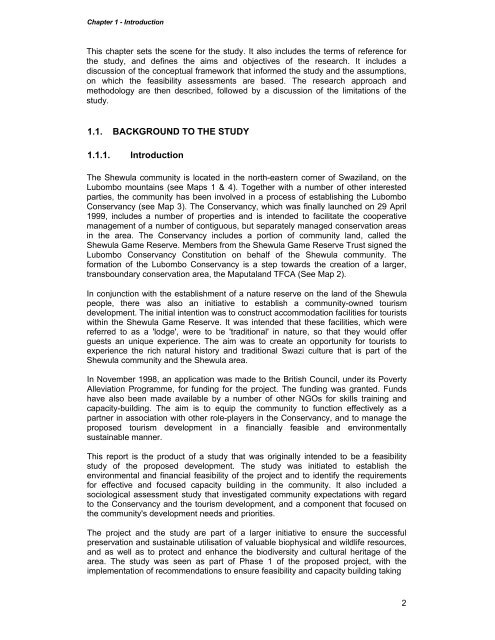Feasibility Study of Proposed Tourism Dev in Shewula, NE ...
Feasibility Study of Proposed Tourism Dev in Shewula, NE ...
Feasibility Study of Proposed Tourism Dev in Shewula, NE ...
Create successful ePaper yourself
Turn your PDF publications into a flip-book with our unique Google optimized e-Paper software.
Chapter 1 - Introduction<br />
This chapter sets the scene for the study. It also <strong>in</strong>cludes the terms <strong>of</strong> reference for<br />
the study, and def<strong>in</strong>es the aims and objectives <strong>of</strong> the research. It <strong>in</strong>cludes a<br />
discussion <strong>of</strong> the conceptual framework that <strong>in</strong>formed the study and the assumptions,<br />
on which the feasibility assessments are based. The research approach and<br />
methodology are then described, followed by a discussion <strong>of</strong> the limitations <strong>of</strong> the<br />
study.<br />
1.1. BACKGROUND TO THE STUDY<br />
1.1.1. Introduction<br />
The <strong>Shewula</strong> community is located <strong>in</strong> the north-eastern corner <strong>of</strong> Swaziland, on the<br />
Lubombo mounta<strong>in</strong>s (see Maps 1 & 4). Together with a number <strong>of</strong> other <strong>in</strong>terested<br />
parties, the community has been <strong>in</strong>volved <strong>in</strong> a process <strong>of</strong> establish<strong>in</strong>g the Lubombo<br />
Conservancy (see Map 3). The Conservancy, which was f<strong>in</strong>ally launched on 29 April<br />
1999, <strong>in</strong>cludes a number <strong>of</strong> properties and is <strong>in</strong>tended to facilitate the cooperative<br />
management <strong>of</strong> a number <strong>of</strong> contiguous, but separately managed conservation areas<br />
<strong>in</strong> the area. The Conservancy <strong>in</strong>cludes a portion <strong>of</strong> community land, called the<br />
<strong>Shewula</strong> Game Reserve. Members from the <strong>Shewula</strong> Game Reserve Trust signed the<br />
Lubombo Conservancy Constitution on behalf <strong>of</strong> the <strong>Shewula</strong> community. The<br />
formation <strong>of</strong> the Lubombo Conservancy is a step towards the creation <strong>of</strong> a larger,<br />
transboundary conservation area, the Maputaland TFCA (See Map 2).<br />
In conjunction with the establishment <strong>of</strong> a nature reserve on the land <strong>of</strong> the <strong>Shewula</strong><br />
people, there was also an <strong>in</strong>itiative to establish a community-owned tourism<br />
development. The <strong>in</strong>itial <strong>in</strong>tention was to construct accommodation facilities for tourists<br />
with<strong>in</strong> the <strong>Shewula</strong> Game Reserve. It was <strong>in</strong>tended that these facilities, which were<br />
referred to as a 'lodge', were to be 'traditional' <strong>in</strong> nature, so that they would <strong>of</strong>fer<br />
guests an unique experience. The aim was to create an opportunity for tourists to<br />
experience the rich natural history and traditional Swazi culture that is part <strong>of</strong> the<br />
<strong>Shewula</strong> community and the <strong>Shewula</strong> area.<br />
In November 1998, an application was made to the British Council, under its Poverty<br />
Alleviation Programme, for fund<strong>in</strong>g for the project. The fund<strong>in</strong>g was granted. Funds<br />
have also been made available by a number <strong>of</strong> other NGOs for skills tra<strong>in</strong><strong>in</strong>g and<br />
capacity-build<strong>in</strong>g. The aim is to equip the community to function effectively as a<br />
partner <strong>in</strong> association with other role-players <strong>in</strong> the Conservancy, and to manage the<br />
proposed tourism development <strong>in</strong> a f<strong>in</strong>ancially feasible and environmentally<br />
susta<strong>in</strong>able manner.<br />
This report is the product <strong>of</strong> a study that was orig<strong>in</strong>ally <strong>in</strong>tended to be a feasibility<br />
study <strong>of</strong> the proposed development. The study was <strong>in</strong>itiated to establish the<br />
environmental and f<strong>in</strong>ancial feasibility <strong>of</strong> the project and to identify the requirements<br />
for effective and focused capacity build<strong>in</strong>g <strong>in</strong> the community. It also <strong>in</strong>cluded a<br />
sociological assessment study that <strong>in</strong>vestigated community expectations with regard<br />
to the Conservancy and the tourism development, and a component that focused on<br />
the community's development needs and priorities.<br />
The project and the study are part <strong>of</strong> a larger <strong>in</strong>itiative to ensure the successful<br />
preservation and susta<strong>in</strong>able utilisation <strong>of</strong> valuable biophysical and wildlife resources,<br />
and as well as to protect and enhance the biodiversity and cultural heritage <strong>of</strong> the<br />
area. The study was seen as part <strong>of</strong> Phase 1 <strong>of</strong> the proposed project, with the<br />
implementation <strong>of</strong> recommendations to ensure feasibility and capacity build<strong>in</strong>g tak<strong>in</strong>g<br />
2












